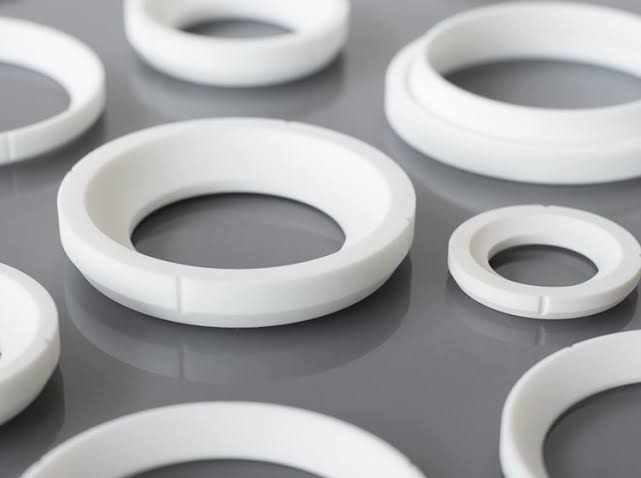The ability of cryogenic seals to maintain integrity is often critical not just for the processes involved but for the safety of humans, other equipment, and the environment. Seal failure could lead to expensive damage, hefty lawsuits, and even loss of life. Finding reliable solutions that can handle cryogenic temperatures and the pressures involved is challenging but not impossible.
PCTFE Ball Valve Seats for Low Permeation Applications
Ball valve seats that show signs of swelling, blistering, or “popcorning” have been permeated at a molecular level. Needless to say, this can cause some serious issues such as leaks and catastrophic failure. The solution is to find a ball valve seat material that is highly resistant to permeation and an excellent choice would be PCTFE. In this week’s blog post, we will talk about PCTFE Ball Valve Seats and how they are used in Low Permeation Applications.
Introduction
Certain types of media may permeate the ball valve seat, leading to swelling, blistering, and leakage. Applications such as chemical processing and petrochemical transport may require a seat material that is resistant to permeation but still exhibits key properties such as low friction, compressive strength, and resistance to deformation is still needed.
How Permeation Works
Permeation refers to the molecular level penetration of gases, vapors, and liquids through a solid material via diffusion. In diffusion, molecules pass from an area of high concentration to an area of low concentration. This can be extremely problematic when a ball valve is being used because of the potential distortion and leaking of the ball valve seat.
Keep in mind that permeation can take place through a surprising variety of materials, including metals and polymers. In addition, some materials are only semipermeable, which means that only ions or molecules with certain properties can pass through the material.
The rate of permeation is directly related to crystal structure and porosity, which is why factors such as density and molecular structure are important when selecting materials for applications where low permeation is important.
Why Permeation is a Problem for Ball Valve Seats
Gas permeation can not only compromise gas stream purity but also result in dimensional changes of the ball valve seat. One form of these dimensional changes is swelling, which can occur if the permeating media becomes a part of the molecular structure of the material. In reinforced polymers, such as glass-reinforced PTFE, swelling can cause separation between the glass fibers and the PTFE matrix.
Another common manifestation of permeation is referred to as “popcorning” or “popcorn polymerization” which occurs due to a polymeric chemical reaction. And among the most notorious source of problems with popcorning and swelling are monomers with extremely small molecular sizes such as Butadiene and Styrene.
Both popcorning and swelling will lead to leakage, and over time popcorning will completely destroy the ball valve seat. This makes the choice of ball valve seat materials extremely important for applications where this is a problem.
PCTFE for Low Permeability Ball Valve Seat Applications
One of the best materials for a ball valve seat application where permeability is a problem would be PCTFE (Polychlorotrifluoroethylene), a thermoplastic chlorofluoropolymer. PCTFE is sometimes referred to as Modified PTFE or PCTFE, as well as by trade names Kel-F, Voltalef, and Neoflon. PCTFE is often thought of as a second-generation PTFE material that maintains the chemical and thermal resistance of PTFE along with its low friction. It is also similar to other fluoropolymers such as PFA or FEP.
One of the defining characteristics of PCTFE is that it has a much more dense molecular structure and a low void and micro-porosity content when compared to similar ball valve seat materials. This gives it a very low permeability coefficient, which means that the likelihood of it swelling or popcorning is far lower than other materials. For example, its permeability for O2, N2, CO2, and H2 are 1.5 x 10-10, 0.18 x 10-10, 2.9 x 10-10, and 56.4 x 10-10 darcy, respectively.
PCTFE also provides improved toughness and strength along with good deformation recovery and excellent creep and cold-flow resistance. In addition, it has a wide operating temperature range of -100°F to 500°F. In fact, it performs extremely well at cryogenic temperatures. Because of its low friction, it also results in a very low ball valve operating torque. PCTFE also exhibits zero moisture absorption and is non-wetting.
PCTFE works well in operating environments where other polymers may fail. For example, it is well adapted to nuclear service that may involve high radiation exposure, is non-flammable (D 635), and is resistant to attack by the vast majority of chemicals and oxidizing agents. The only chemicals that might lead to slight swelling are ethers, esters, aromatic solvents, and halocarbon compounds.
In addition to its use in applications requiring low permeability, PCTFE is also considered an excellent choice for applications that need a low-outgassing material and is commonly used in semiconductor applications. Also note that there are PCTFE grades that are FDA approved, such as Fluorolon PCTFE 2800.
Conclusion
Fuel processing and transport, chemical processing, petrochemical systems, and emissions control are just a few of the applications where low permeation materials may be necessary. For such applications, PCTFE is an excellent option for ball valve seat materials because it combines the basic properties necessary for a seat with an extremely low rate of permeation.
If you need a solution to blistering, swelling, or popcorning of a ball valve seat, contact the experts at Advanced EMC. Our sealing team will work with you to find the right ball valve seat material for your application.


